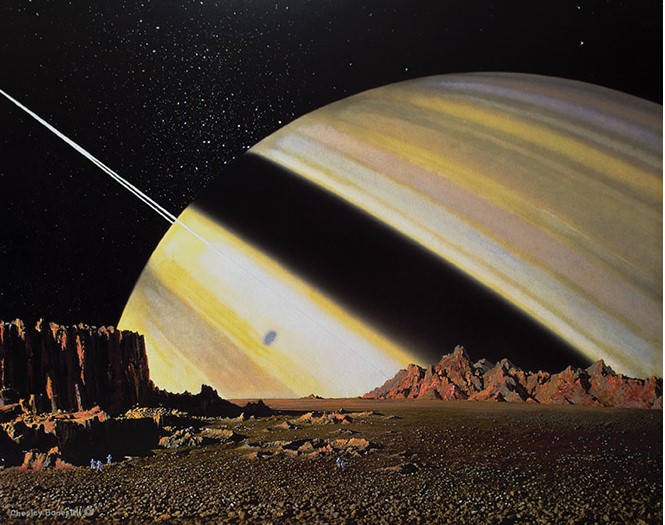- Home
- Saturn and its moons
- What to See on Mimas
what to see on mimas
For a scenic browse, and an answer-page for Guess The World...
ruins on mimas, left by beings from the
ring-progenitor moon
He now saw that some of the larger rocks were strangely angular. Pushing some around, he noticed more. Calling Arpad, they explored the area thoroughly. There were many such angular rocks, and now in several spots they noticed that one or two such were still perched on top of others. Bruce found a little piece of reddish stuff, plastic of some sort, probably part of a machine, though he couldn't place it. Arpad turned up some bits of broken material which looked like splinters of a smashed vase or pot.
When they came back to Garcia, and sat around and discussed their findings, they knew they had come across one of the most amazing discovering in interplanetary history. Clearly there had once been a city standing in this plain on Mimas. A city that had crumbled into ruin and dust probably hundreds of thousands of years ago - and a city that defied all the logic of life.
Garcia
explained this, "How could life survive here? There could never have
been enough air here, even when this satellite was new and still hot
from its creation. My guess is that this city was a colony planted from
somewhere else. But where and who could it have been that was here so
many lost ages ago - back before there were even men on Earth...?"
Donald A Wollheim, The Secret of Saturn's Rings (1954)
admiring the view on mimas
 by Chesley Bonestell (1944); shows a different time of day from that of the narrative but, apart from that, it's a good fit
by Chesley Bonestell (1944); shows a different time of day from that of the narrative but, apart from that, it's a good fit“We came down in a wide valley between a couple of mountains, where we were sure the ground would be pretty solid. We weren’t going to make the mistake we did on Rhea! It was a good landing, and we climbed into our suits to go outside. It’s funny how impatient you always are to do that, no matter how many times you’ve set down on a new world.
“Of course, Mimas hasn’t much gravity – only a hundredth of Earth’s. That was enough to keep us from jumping off into space. I like it that way: you knew you’d always come down safely again if you waited long enough.
“It was early in the morning when we landed. Mimas has a day a bit shorter than Earth’s – it goes round Saturn in twenty-two hours, and as it keeps the same face towards the planet its day and month are the same length – just as they are on the Moon. We’d come down in the northern hemisphere, not far from the equator, and most of Saturn was visible above the horizon. It looked quite weird – a huge crescent horn sticking up into the sky, like some impossibly bent mountain thousands of miles high…”
Arthur C Clarke, The Sands of Mars (1951)
>> Guess The World - Fourth Series


































